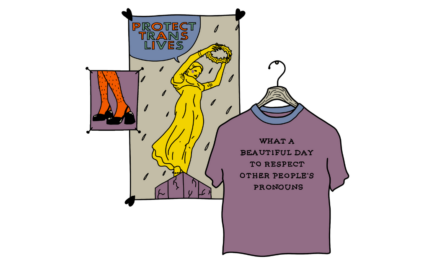Lesbian Bed Death – a term often debated in queer circles – refers to the perceived phenomenon where sexual activity and intimacy seem to fade in long-term lesbian relationships. It’s a sort of mythological beast haunting sapphic love lives, suggesting that as time goes by, passion dwindles and lesbians are doomed to face a life devoid of eroticism.
The first time the term was publicly heard was allegedly in 1987 during a march for gay rights in Washington D.C., only four years after its conception by Philip Blumstein and Pepper Schwartz, a sociologist and a social psychologist who after launching a survey answered by 12.000 people, concluded that lesbian couples stop having sex around two years into a long-term relationship. Luckily, their research was met with great resistance from academics and the general public due to lack of valid scientific evidence to back their argument up. If you’re rolling your eyes here, do know you’re not alone. The fact is that the majority of couples in the study reported a decrease in frequency of sexual activity after a certain period of time, yet Philip and Pepper insisted on classifying this trend as an exclusively lesbian problem. The term now haunts sapphics, despite the study’s methodology having been largely questioned. As if that wasn’t enough, the book that published the study had the audacity to state that lesbians are less adventurous and less technically skilled in the bedroom. These arguments are not only laughable – women having experienced sex with both men and women would laugh at their absurdity – but also problematic.
Coining the term ‘’Lesbian Bed Death’’ reveals a larger issue as it reinforces the existing stigmas lesbians face around their sexuality. The sex lives of lesbians are already so often speculated upon by clueless and tactless heterosexuals through comments such as: ‘’But how do you even have sex? Have you ever had good d*ck? Who is the man in the relationship?’’ and other terrible remarks. Spreading inaccurate information about their intimacy only fuels this notion that lesbians are fundamentally lacking something in their relationships and that this ‘something’ invariably leads back to ‘the penis’.
Turning to the opposite end of stereotypes about lesbian sex we come across the most common cliches which relate to how lesbians have sex very often, and how these sessions last long, as well as the notorious science-backed gem that states that women who sleep with women are having the best quality orgasms across the entire female population. While some may agree with these statements, highlighting lesbian sex may intensify feelings of shame and guilt among women who do not align with these ideals, causing them to question if something is wrong in their own sex life. The fear of falling under the ‘LBD’ category in addition to not meeting the positive stereotypes can be much to bear.
It is important to understand that not everyone has the same sex drive, not everyone prioritizes sex in a relationship, and that people go through phases of psychic volatility, which impacts their relationship with their bodies and their general state of mind. All factors affecting the frequency they engage in intercourse. Sexing little can reflect various things about people that are unrelated to how attractive, interesting, capable, or good of a partner they are.
Exploring further the prevalence of the Lesbian Bed Death phenomenon, aside from there being insufficient credible qualitative data on the matter, it’s worth noting that lesbian couples often develop a fusional relationship with each other where emotional intimacy is prioritized over sexual contact. This supports the ‘Lesbian Bed Death’ argument. Over time, once the honeymoon phase ends, it’s the day to day companionship and shared mental resonance that matters most for many long-term couples. Besides, as time passes and people settle in a more secure space within their relationships, there’s often a shared sense of having less to prove to one another which in return can make people more comfortable with being honest about being tired or not in the mood for play time.
Additionally, as a sapphic friend of mine pointed out, in comparison to straight bonds, lesbians are able to communicate a lack of drive or decline any advances made by their partner and are certain to have their boundary respected. For our hetero female counterparts, the reality is rather different, with many women feeling somewhat pressured to give into sex in order to keep their partners attracted to them or due to fear of being cheated on.
Leaning into an honest view of things, ‘Lesbian Bed Death’ can be a reality for some couples due to fundamental differences between homosexual and heterosexual pair-bonding dynamics. Whilst lesbians share a sense of mental and bodily familiarity with each other, that might affect eroticism as it leaves little for the imagination to entertain. When it comes to straight couples, there’s a greater space of unknown shared between two individuals. Women are enigmas men crave to uncover, and women are often trying to understand male behavior they find uncanny. Mystery fuels fantasy. The promise of novelty sparks interest in heterosexual couples. The statistics show however, that they aren’t immune to ‘bed death’ either.
If a decline in sexual activity is part of your reality, it’s worth acknowledging this isn’t a phenomenon exclusive to lesbian couples. Also identifying with the term ‘Lesbian Bed Death’ might only amplify feelings of shame and inadequacy, neither of which assist in managing the situation effectively. Tools that come in handy to tackle the ‘LBD’ beast are open communication, setting aside designated intimacy time, as well as intentionally experimenting more with your partner. Ultimately, it is within our power to decide the importance we assign to the concept and implications of Lesbian Bed Death. Sexless periods are natural for everyone, especially when you are committed to one person for the long run.
Illustration: Ernesto Testi





